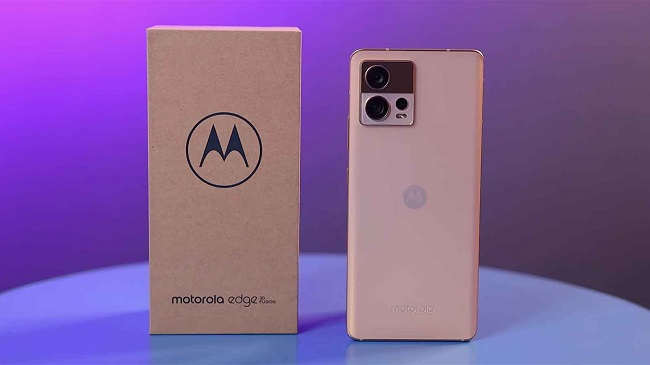According to Motorola, the Edge 30 is the lightest and thinnest 5G smartphone available in India. The consequence of the designers’ fixation was a phone that was only 6.79mm thick and weighed 155g.
The Motorola Edge 30 is the follow-up to last year’s similarly priced Motorola Edge 20 (Review). Motorola’s apparent focus on the Edge 30’s aesthetics as a selling factor raises the question of whether or not the device sacrifices substance for form.
Specifically, does the Motorola Edge 30 strike a good balance between the two? To discover out, I decided to put it to the test.

Motorola Edge 30 Design
The Motorola Edge 30 places an emphasis on form. Following the lead of the iPhone 12, Motorola has streamlined the Edge 30’s body to make it more comfortable to hold. The Edge 30’s rounded sides and edges, however, make it comfortable to hold.
The Edge 30’s body is built of polycarbonate to keep the weight down, as I noted in my initial thoughts on this device. Although it appears to be made of glass, the back panel is really acrylic, making it less likely to break if dropped.
It’s flat, and right in the middle is the Motorola logo. The panel’s susceptibility to fingerprints is addressed by the protective case provided. Using the Motorola Edge 30 for extended periods of time did not tire my hands because of its comfortable design and light weight.
Several aesthetic cues from the Edge 30 Pro served as inspiration for this phone (Review). It has a similar-looking camera module and, as I’ll explain below, the same camera hardware.
Motorola Edge 30 Specifications and Software
Compared to the Snapdragon 778G found in the Motorola Edge 20 (Review), the Qualcomm Snapdragon 778G+ SoC is what drives the Motorola Edge 30. When it comes to smartphones in India, the Edge 30 is also the first to feature this particular Processor.
It’s compatible with 13 different 5G bands and has Bluetooth 5.2, Wi-Fi 6E, NFC, and more. Some potential consumers may be put off by the fact that the Edge 30’s storage capacity cannot be increased.
Dolby Atmos and Snapdragon Sound are two of the upgrades included in the Edge 30’s dual speakers. The Motorola Edge 30 sports a pOLED screen size of 6.5 inches with a full HD+ resolution.
The 144Hz refresh rate and 360Hz touch sampling rate are particularly impressive. Motorola claims that a pOLED panel’s use reduces the display’s overall thickness while also allowing for thinner bezels. The display on the Edge 30 is safeguarded with scratch-resistant Corning Gorilla Glass 3.
Motorola Edge 30 Performance
During my time with the Motorola Edge 30, I never had any hiccups. It has a clear pOLED screen with wide viewing angles. By default, the display’s refresh rate is set to Auto, and with this setting, I’ve found that the UI is refreshed at 90Hz.
The lock screen was the only location where the refresh rate changed to 144Hz; otherwise, the user interface, including menu scrolling, ran at a more pedestrian 90Hz. To get the full 144Hz, you’ll need to lock the refresh rate in the Settings app; doing so makes the screen feel slightly smoother, but not noticeably so.
The user experience was satisfactory even when I left it on Auto, so that’s what I recommend. The monitor and dual speakers made for an enjoyable video watching experience.
The Motorola Edge 30 is an attractive option for consumers seeking a mobile device primarily for media consumption. The Motorola Edge 30’s in-display fingerprint reader is an improvement, but it’s not the quickest one I’ve used.
There were times when verifying my fingerprint took too long. Motorola has implemented an entertaining fingerprint animation to keep you occupied while the scanner completes its task. Unlocking the phone with facial recognition took only a short amount of time.
Motorola Edge 30 Cameras
Both the Motorola Edge 30 and the Motorola Edge 30 Pro have the same camera hardware. It has a primary camera with OIS and 50 megapixels, a secondary camera with 50 megapixels with macro capabilities, and a depth camera with 2 megapixels.
The Edge 30 lacks a powerful zoom function in comparison to the Edge 20, which has a 3X telephoto camera. The camera’s user interface, however, remains mostly unaltered and is intuitive. The camera app has a “Pro” option that allows you to set the exposure manually.
Conclusion
It is 159.4 x 74.2 x 6.8 mm in size. The Qualcomm SM7325-AE Snapdragon 778G+ 5G Octa-core CPU drives Android 12 on this smartphone. The device’s rear cameras are a triple configuration consisting of 50 MP (wide), 50 MP (ultrawide), and 2 MP (depth), while the front shooter is a single 32 MP unit (wide).
AMOLED capacitive touchscreen display measuring 6.5 inches in diagonal with a resolution of 1080 by 2400 pixels. Fingerprint, compass, accelerometer, gyroscope, and proximity sensors are located on the device’s sides.
The Motorola Edge 30 has a variety of navigational aids including A-GPS, GLONASS, BDS, and GALILEO in addition to Bluetooth 5.2, NFC, USB Type-C 2.0, and more. The smartphone has 8 GB of RAM and either 128 GB or 256 GB of storage space on the inside.
Rapid charging @ 33 watts and a sizable Nonremovable Li-Po 4020 mAh battery are included. For the most recent mobile devices, giztop.com is where you should go to find the best offers, coupons, comparisons, reviews, and more.









































